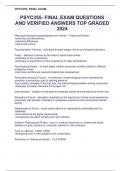Exam (elaborations)
PSYC355- FINAL EXAM QUESTIONS AND VERIFIED ANSWERS TOP GRADED 2024
- Course
- PSYC355
- Institution
- Athabasca University (AU )
Main psychoanalytic psychologists/main themes - -Freud and Erikson -continuity and discontinuity -individual differences -nature and nurture Psychoanalytic Theories - child goes through stages, driven by biological maturation Freud - -behavior is driven by the need to satisfy basic drives...
[Show more]



